The first major overhaul of the transcriptions took place in June 2020.
1. Manuscript Min
The first, and most important, change we have made is the addition of the transcription of another manuscript, University of Minnesota Z946.02/fC88I known by the siglum Min. We have not, as yet, incorporated the images into the edition as such, but as is mentioned in the description of manuscripts, images of Min are available for consultation at the University of Minnesota.
The transcription was made by Lauren Brinsdon in the context of the thesis “Medieval Textuality as a Temporal Lens: The Minnesota Manuscript from the Estoria de Espanna” which she successfully presented for the degree of Master of Arts by Research in the University of Birmingham in 2018. As yet, the transcription of Min has not been incorporated into the collated text of the VPE, and it can therefore only be accessed through the usual drop-down menu at the top of the page:
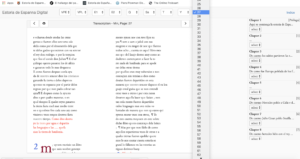
or (by chapter) in the Índice menu at the right of the edition page (see below for further updates on the index).
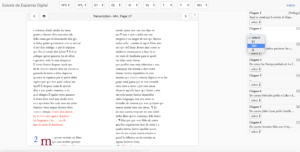
There are a number of additional features in this transcription (some of which have been added to other manuscripts, for which see below). The manuscript is fragmentary, as it suffers from many lacunae, and it is the product of at least two principal scribes and multiple versions of the Estoria. In her thesis, Brinsdon was able to analyse the structure of the manuscript quite closely, and to identify the number of quires that it must originally have comprised. The following diagram, (Brinsdon, 2018, 114) demonstrates the structure of the codex and the versions which supplied the source (the dotted lines represent quires):
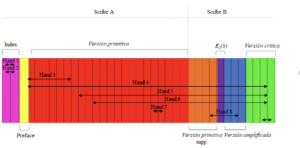
In presenting this transcription then, there are a number of elements which have to be taken into account.
i. Foliation: In the first instance, pagination is problematic, as the manuscript is so fragmentary and the various foliation methods in the codex itself defective. Consequently, it is advisable to employ the image numbers from the University of Minnesota digitization as a standard method of referring to the elements of the manuscript, and these are therefore employed in the drop down menu. As a result, the foliation employed here refers to the manuscript as it currently exists, and not to any previous or original state of the codex.
ii. Numbering system: As the manuscript contains, at least in part, text from the versión primitiva and the versión crítica, the standard Estoria de Espanna Digital chapter numbering system cannot be employed across the entirety of Min. The text of the versión primitiva of the Estoria proper begins with EED chapter 1 on image 24 and it runs (with significant lacunae) to EED chapter 696.9 which comes to an end on image 389. At this point, and up to image 482 where the manuscript ends, the text is drawn from the versión crítica. To allow for cross reference, since the chapters are not comparable to those of the versión primitiva, here we have employed the standard numbering system developed for the editions by Inés Fernández-Ordóñez and Mariano de la Campa respectively. The text in Min corresponds to chapters CXIII to CXCII inclusive. We have therefore included these chapter numbers at the beginning of each chapter in the format (e.g.) cxiii. However, we have not as yet attempted to provide a numbering system at any lower level, so each chapter at present only contains one subdivision. Additionally, and again to allow cross reference, we have included pointers to the equivalent folios in Ss as mouseovers in the transcription of Min. where the two texts correspond.
iii. Fragments and other issues: Image numbers 139 and 140 are fragmentary. The small fragments at the top of the folios concerned, from chapter 181, broadly fit into the sequence of the text around them, but the larger, non-attached, pieces from chapter 567, do not. These pieces have clearly been added in error but are now part of the manuscript in this form. We have numbered these as 139.5 and 140.5 respectively. Furthermore, between page/image numbers 103 and 104 there is a missing folio. The text and folio concerned are in fact in situ in the manuscript, so this may be due to an imaging error. We have numbered these as 103.5 and 103.6 respectively. Of course, if the missing images are ever added, it may be necessary to revise the numbering of the manuscript as a whole.
2. Alterations to the Versión Crítica transcription (Ss)
We have made some corrections to the transcription of Ss. In particular, folio 134v was missing previously and we have now added this. Furthermore, and more significantly, we have added chapter numbers and other information to facilitate cross reference.
Ss is comprised of a variety of versions.
- Folio 2r to 84v is versión primitiva text corresponding to EED 397.5-607.24 inclusive.
- Folio 84v to 264v is versión crítica text. Here we have added the standard chapter numbering from the editions by Fernández-Ordóñez and de la Campa. The text in Ss comprises chapters XXXIII to CCCCIII inclusive. Each chapter is therefore given the corresponding number in the format (e.g.) xxxiii but no attempt has been made to add numbering for any lower level division. A number of chapters are missing in Ss (cxxxix) and Min (cxxiv-vi, clxv-clxvii) respectively, so these chapters do not appear in the index or the manuscript transcriptions. Additionally, a number of chapter divisions and rubrics appear in one or both manuscripts which do not appear in the printed editions. To preserve the standard numbering, these are marked here with the number of the previous chapter followed by bis, e.g. clibis. The number for chapter ccxxiibis has been added in as ccxxii appears to have been used, in error, twice in the Campa edition (pp.397-8).
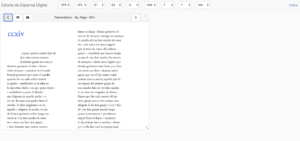
- Folios 264v to 279v contain text from the Crónica de Castilla. As there is no standard numbering system for the Crónica de Castilla, we have not added chapter numbers. However, we have included in notes (via mouseover) reference to the equivalent text in the edition by Rochwert-Zuili.
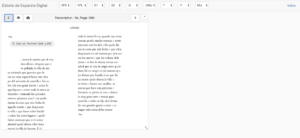
- Folio 279v to the end of the codex in folio 325r contains the Crónica particular de san Fernando, which is numbered, as before, in line with the Estoria de Espanna Digital numbering of chapters 1040-1146 inclusive. This text is also included in Polly Duxfield’s edition of the CPSF.
3. Alterations to the transcriptions of E1 and E2
We have made some minor corrections to the transcriptions of the central two manuscripts. We have removed some editorial notes. To facilitate cross reference to the PCG edition, we have included reference to the equivalent PCG chapter as a hover over at the beginning of each chapter. These PCG chapter numbers can also be found in braces in the chapter list in the Índice menu.
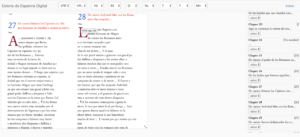
4. Alterations to the Versión primitiva editada
The link between the footnotes in the VPE and manuscript T was the source of a slight error in the past, from chapter 535 onwards. We have corrected this error, and all internal links in the edition should now function correctly.
5. Update to the Index
As Min and Ss now include chapters with a separate numbering system corresponding to the versión crítica, the drop-down Índice menu contains a direct link to these chapters. This part of the index begins after the last EED chapter – EED 1146. The additional versión crítica index runs between chapters xxxiii and cccciii, which represent the text of the versión crítica in Ss. Additionally, links to the text of Min corresponding to chapters cxiii to cxcii of the versión crítica can also be found in this index.
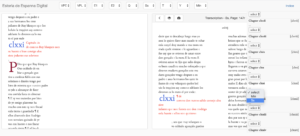
Some of these changes will also occasion a slight alteration to the standard way of citing the edition. This alteration is noted in the How to cite this edition page.
Downloads
We will, of course, keep up to date all of the transcriptions and code on GitHub and Zenodo. All of the edition materials, including the new transcriptions can be found at:
The transcriptions: DOI 10.5281/zenodo.2593589
The website data : DOI 10.5281/zenodo.2593583
The processing code: DOI 10.5281/zenodo.2593580
The project would like to thank, in particular, Cat Smith, Lauren Brinsdon and Elena Caetano Álvarez for their part in this update, and to Milly Clements for pointing out a few errors in 2022, which have now been corrected . We would also like to thank Marguerite Ragnow and Michelle Hamilton of the University of Minnesota for their help in accessing the manuscript.
Bibliography:
Lauren Paige Brinsdon, Medieval Textuality as a Temporal Lens: The Minnesota Manuscript from the Estoria de Espanna, MA by Research thesis (Birmingham: University of Birmingham, 2018).
Ines Fernández-Ordóñez (ed.), Versión crítica de la Estoria de Espanna. Estudio y edición desde Pelayo hasta Ordoño II, Fuentes cronísticas de la Historia de España VI (Madrid: Fundación Ramón Menéndez Pidal/Universidad Autónoma de Madrid, 1992).
Mariano de la Campa Gutiérrez (ed.), La Estoria de Espanna de Alfonso X. Estudio y edición de la versión crítica desde Fruela II hasta la muerte de Fernando II (Málaga: Universidad de Málaga, 2009).
Patricia Rochwert-Zuili (ed.), Crónica de Castilla: Édition et présentation. Nueva edición [en línea].
(Paris: e-Spania Books, 2010) Disponible en Internet: <http://
books.openedition.org/esb/63>. ISBN: 9782919448074. DOI: 10.4000/books.esb.63. Accessed 28 /11/2019.
